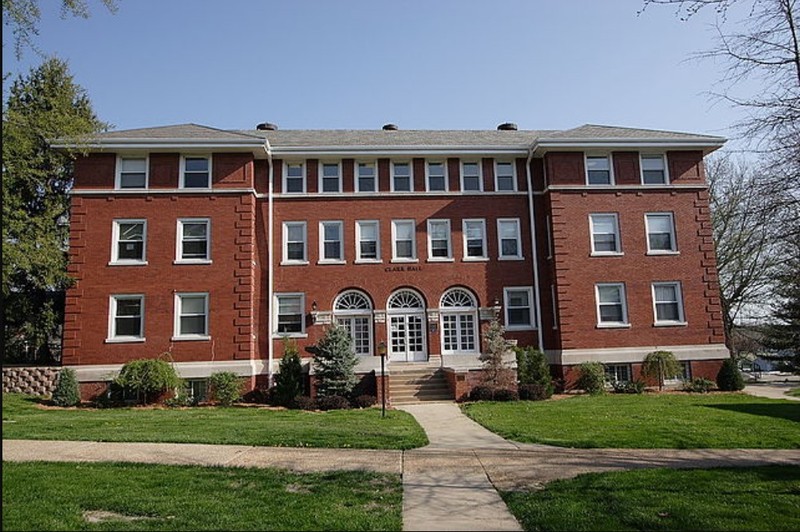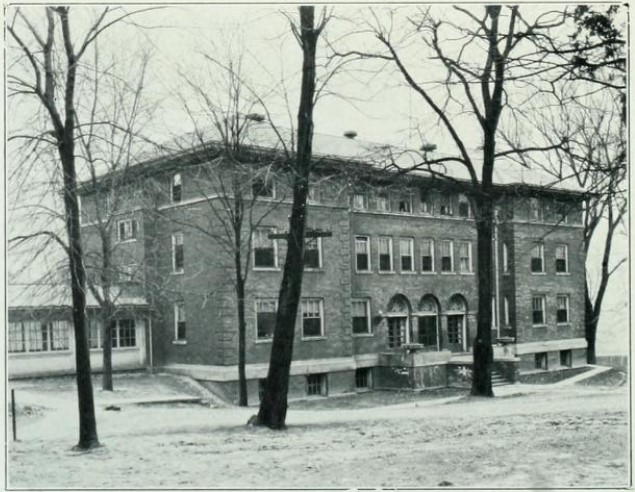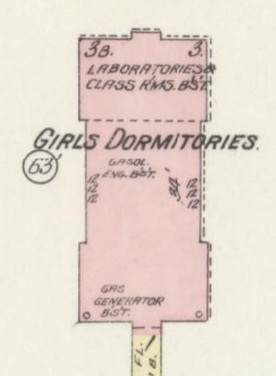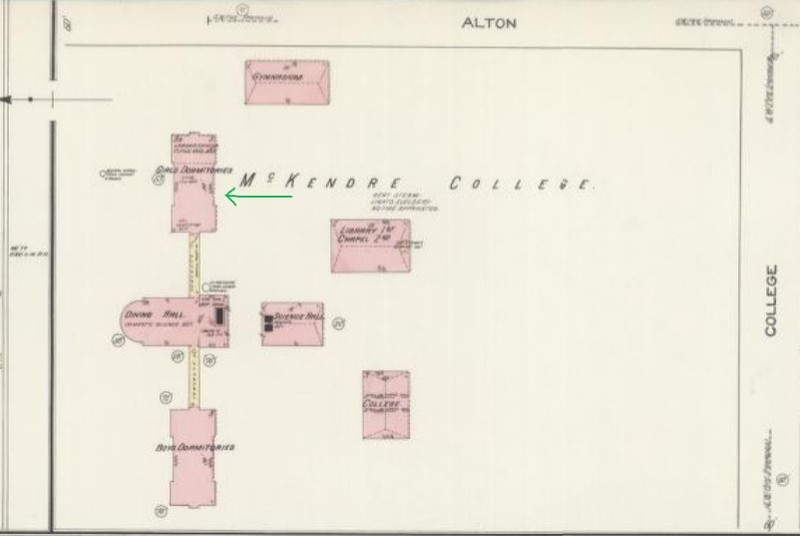Clark Hall, McKendree University
Introduction
Text-to-speech Audio
Built in 1910 to 1911 as the residence hall for female students at McKendree College, Clark Hall now houses McKendree University's computer lab, and a number of staff and faculty offices. Student Affairs, Leadership and Student Development, International Student Services, and Show Choir are some of the occupants. Women were first admitted to McKendree College in the fall of 1869. For part of World War II, Clark Hall was divided into dorms for female students in the west half with male students in the east half; the male dormitory, Carnegie Hall, was converted into housing for Scott Field military personnel.
Images
Modern photo of Clark Hall (Robert Lawton 2006)

Clark Hall in photograph from 1928 book marking centennial of McKendree College

Clark Hall close-up on 1914 Sanborn map of McKendree campus (p. 7)

Whole McKendree College campus and Clark Hall (green arrow) on 1914 map (Sanborn p. 7)

Backstory and Context
Text-to-speech Audio
Twenty women were admitted to McKendree College in the fall of 1869, the first year that women were allowed to attend. The college lacked dormitories and many students lived in nearby boarding houses. The Clark brothers of Philadelphia donated $10,000 to McKendree College. When the new dormitory for women was built at McKendree in 1910, it was named after the Clarks. Clark Hall was the fifth brick building added to the campus, joining Old Main (1850), the Chapel (1857), Athleteon (1868 - later Science, now Wildy Hall). and Eisenmayer Auditorium (1903; demolished); the original wood-frame building from the college's founding in 1828 burned down in 1856. A boys' dormitory (Carnegie, named for donor Andrew Carnegie) and a dining hall (Pearsons) also were built in the 1910-1911 time period; they - along with Clark Hall - were ready by the last term in the 1910-1911 school year. There were laboratories and classrooms in the basement of Clark. Concrete walkways connected the dorms to the dining hall between them. College president during construction was John F. Harmon, a 1900 recipient of a Doctor of Divinity degree from McKendree; he served from 1908 to 1915 and then went on to become president of Kansas Wesleyan University.
Clark Hall was renovated during the summer of 1951. The student lounge on the first floor of Clark was a popular place but was in need of sprucing up by the 1960s. The wife of college president Max P. Allen took on the project with the aid of the "McKendree Dames," a ladies' organization with members from the faculty, staff, and local community. An influx of new students in the early 1960s overwhelmed the capacity of the two dorms (Clark and Carnegie). The college purchased buildings just north of campus that had been built to house students of the Southern Illinois Conference of the Methodist Church and renovated them to become McKendree student housing. McKendree paid $45,000 for the buildings, named Wesley and Cartwright Halls. The college allowed the conference to house up to 350 institute students on McKendree's campus in the summers for free. When the new school year began in 1966, Clark Hall was a men's dorm. Student numbers living on campus declined by the mid-1970s and Clark Hall was vacant. A $140,000 grant from the Fellheimer Trust in 1974 funded refurbishing of Clark. The building was converted into classrooms, a psychology laboratory, an audiovisual center, a computer laboratory and office space. The completely refurbished building officially reopened on November 20th, 1976.
Environmental remediation was done within Clark Hall in late 2015 in response to an unusual cluster of respiratory illnesses in people with offices in the building. Faculty and staff moved out of their offices and the computer lab was closed. The basement was found to have the most issues with mold due to water entering cracks in the foundation and flooding after heavy rainstorms. Drains were installed to move water away from the foundation which was re-sealed. Also, carpeting and floor tiling containing asbestos were removed from the basement before the building was re-occupied.
Sources
Belmonte, Anna. "The Mold that Made them Move." The McKendree Review (Lebanon) October 30th, 2015.
Belmonte, Anna. "A Further Look into the Mold in Clark." The McKendree Review (Lebanon) November 13th, 2015.
Keller, Steve. McKendree College History Committee. McKendree College History 1928-1978. Paducah, KY. Turner Publishing Company, 1996.
McKendree College. Catalogue of McKendree College, Lebanon, Illinois, 1910-1911. Edition Reprint. online. Forgotten Books, 2018.
McKendree University. McKendree Presidents, McKendree University. January 1st, 2022. Accessed December 23rd, 2022. https://www.mckendree.edu/offices/president/presidents.php.
McKendree University. Interactive map, Campus Map. January 1st, 2022. Accessed December 27th, 2022. https://www.mckendree.edu/about/visitor/campus-map.php.
Sanborn Map Company. Map of Lebanon, St. Clair County, Illinois. New York, NY. Sanborn Map Company, 1914.
Walton, William Clarence. Centennial McKendree College with St. Clair County History. Lebanon, IL. McKendree College, 1928.
https://commons.wikimedia.org/wiki/File:Clark_Hall.JPG
Walton, William C. 1928 book p. 316; St. Clair County Historical Society: http://stcchs.org/research/onlineresources.php
Library of Congress (LOC): https://www.loc.gov/item/sanborn01967_004/
LOC: https://www.loc.gov/item/sanborn01967_004/
